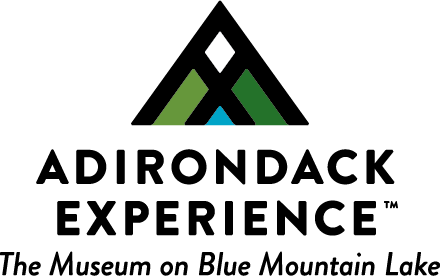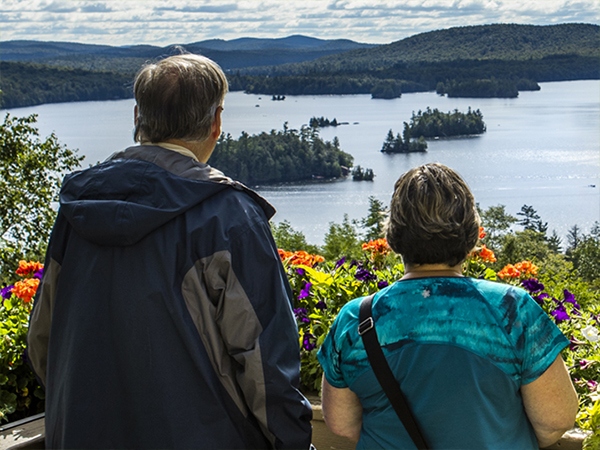In 1904 the Hochschild family acquired a share in a large property known as Eagle Nest in Blue Mountain Lake. Harold spent summers there and gained a lifelong passion for the Adirondack region. He became particularly interested in the Adirondacks’ history, collecting documents and interviewing local residents. In 1952 he published a mammoth, illustrated book, Township 34, about the area immediately surrounding Blue Mountain Lake.
A group of dedicated Blue Mountain Lake residents organized The Adirondacks Historical Association in 1947. Their ambition was to build a local history museum. They acquired a site in the center of the Hamlet of Blue Mountain Lake and commissioned drawings for a modest building to house operations. Those early plans never moved forward. Hochschild subsequently assumed control of the association in 1953. He purchased a much larger property for the project, the former Blue Mountain House resort, located about 1.5 miles from the hamlet’s center. On that elevated spot with sweeping views of Blue Mountain Lake, he built the original Adirondack Museum, which opened its doors to the public in 1957. Hochschild personally subsidized the museum’s operations and led its board until his death in 1981.
In addition to his involvement with the Adirondack Experience, Hochschild pursued many other civic and philanthropic interests. He served on the boards of the New York State Historical Association, the Institute for Advanced Study at Princeton, and the Correctional Association of New York, among other organizations. In 1970 Governor Nelson Rockefeller tapped him to chair the Temporary Study Commission on the Future of the Adirondacks, which was charged with making recommendations for the Adirondack Park’s long-term conservation and management. While the park was officially established as early as May 20, 1892 (coincidentally the day Hochschild was born), it enjoyed few legal protections. After what turned out to be a contentious behind-the-scenes struggle, Hochschild successfully managed to push through legislation authorizing the creation of the regulatory Adirondack Park Agency. Governor Rockefeller signed the legislation into law on June 25, 1971.
The personal wealth that enabled Hochschild to establish the Adirondack Experience and support his other philanthropic interests derived from his interests in a company known as American Metal. He joined the company in 1913 at a time when his own father, Berthold Hochschild, was chairman. Harold eventually became president, then chairman. While he was chairman, American Metal merged with another company and became American Metal Climax. In 1957, Hochschild stepped down as chair but continued to serve on the board until 1974.
The Adirondack Experience is mindful that from the 1930s through the 1950s, American Metal’s profits, and the Hochschild family’s wealth, were largely derived from mining operations in the Copperbelt of what later became Zambia. Low wages paid to thousands of African workers in what was then a British colony contributed to the company’s high profitability. Working and living conditions in company-owned housing could be harsh and even brutal. For much of this period, prejudicial work rules prevented Black people from holding supervisory and executive-level positions. These unfortunate realities are at odds with the values of the Adirondack Experience and our nation today. The museum recognizes that Hochschild’s philanthropy and the Adirondack Experience’s current financial strength were, at least in part, facilitated by harm done to others, which is regrettable.
In 2023 the Adirondack Experience commissioned a report about American Metal’s business practices from Duncan Money, PhD, a historian specializing in the subject of copper mining in Africa. His report can be accessed ici. Money observed that for much of its history, American Metal supported the status quo in colonial Africa. He also noted that American Metal, under Hochschild’s leadership, eventually shifted its position to encourage anti-colonial leaders in Northern Rhodesia (now Zambia) as it transitioned towards independence and did so “before any other section of big business.” Hochschild additionally became chair in 1957 of the African American Institute, now the Africa-America Institute, whose purpose was to provide opportunities for African students in both United States and Africa. In 1960 he also hosted an important anti-colonial nationalist, Kenneth Kaunda, at Eagle Nest and helped introduce him to elected officials and the World Bank. Hochschild provided support for political prisoners in South Africa and Southern Rhodesia during the 1960s.
Throughout his life, Harold K. Hochschild continually deployed his capacity for hard work, political influence, and generosity to create change and further important causes. The Adirondack Experience is grateful to him for his dedication to preserving the stories and material culture of the Adirondacks as well as the landscape itself. In this, Hochschild leaves behind a legacy that remains central to the mission of the Adirondack Experience.
Information about the Adirondack Experience’s current work in the area of Diversity, Equity, Access, and Inclusion can be found ici.
More about Harold K. Hochschild’s life, which included serving as an American intelligence officer during WW II who interrogated German prisoners of war, can be found in two books. The first was edited and the second was written by his son, Adam Hochschild. The first, Harold K. Hochschild 1892-1981, was privately printed in 1982. The second, Half the Way Home: A Memoir of Father and Son, was published by Houghton Mifflin and is still in print. Both are available for review in the library of the Adirondack Experience.


![Gov. Nelson Rockefeller signs the Adirondack Park Agency Act on June 22, 1971 as commissioners (left to right) Fred O’Neal, Peter Paine, Stewart Kilbourne, Henry Diamond, Robert Hall, Richard Lawrence and (seated) Chairman Harold Hochschild look on. Gov. Nelson Rockefeller signs the Adirondack Park Agency Act on June 22, [sic] 1971 as commissioners (left to right) Fred O’Neal, Peter Paine, Stewart Kilbourne, Henry Diamond, Robert Hall, Richard Lawrence and (seated) Chairman Harold Hochschild look on. New York State photo from the collection of the Lake George Mirror](https://www.theadkx.org/wp-content/uploads/2023/08/APA-Act-Signing-Lake-George-Mirror-Wands-scaled.jpg)
